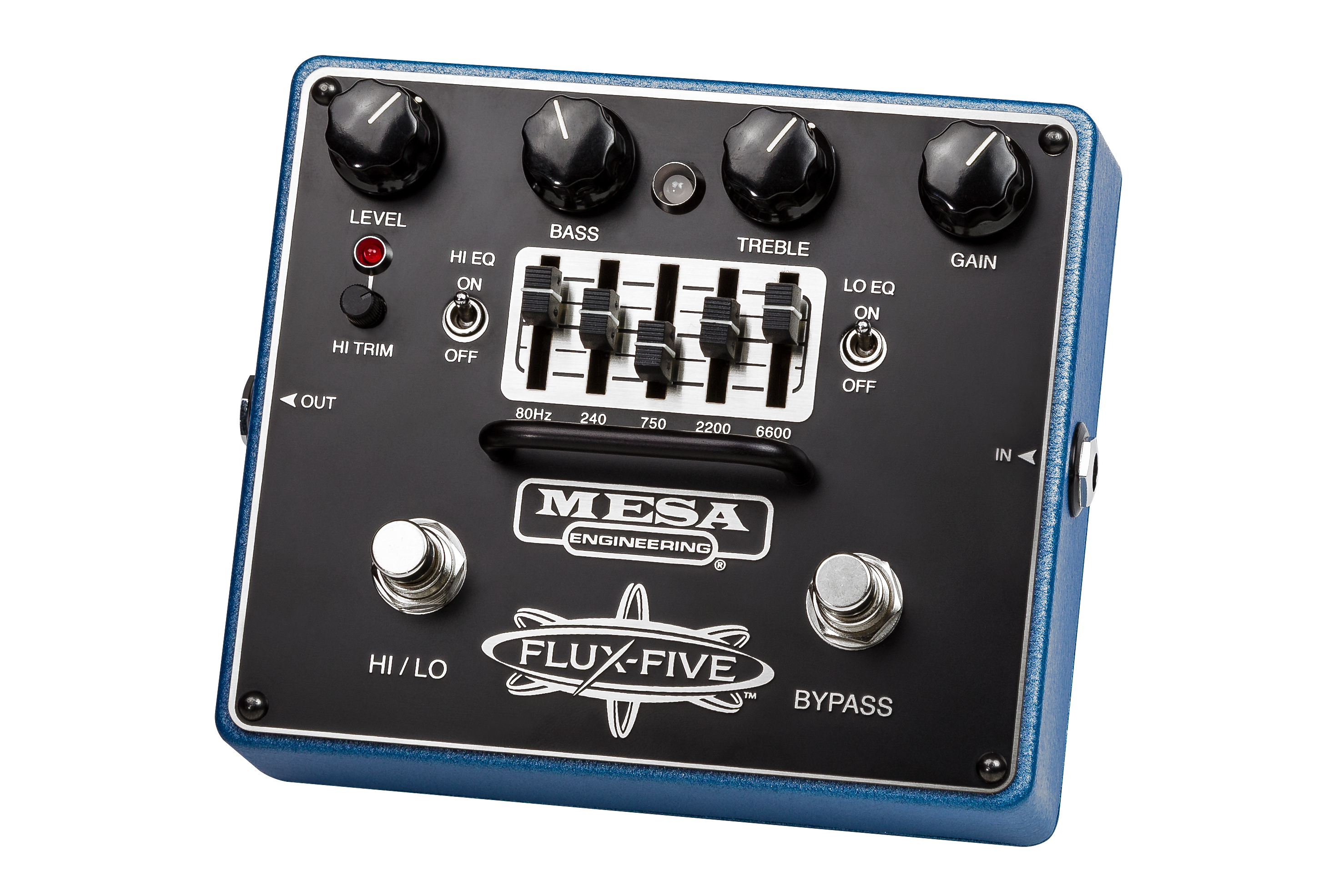Review: Mesa/Boogie Five-Band Graphic, Flux-Five and Throttle Box EQ Pedals —Video

Someone could write a PhD thesis on Mesa/Boogie’s scores of user-interfaced tone-shaping circuits and their permutable effects.
The simplest, most powerful and iconic of these innovative tools is undoubtedly Mesa’s five-band graphic equalizer. Developed by Randall Smith in the early Seventies, the circuit features a quintet of frequency sliders that lets players morph a Mesa amp’s response far beyond what can be achieved with the tone knobs alone.
It’s most often utilized to achieve the supercharged mid-scooped tonal curves that have forged the distinctive sound of hard rock and metal guitar.
Mesa/Boogie is now making its game-changing EQ available to everyone in the form of three thoughtfully engineered stomp boxes: the standalone Boogie Five-Band Graphic, the high-gain Flux-Five outboard preamp pedal and the Rectifier-in-a-can Throttle Box EQ. Like the EQ circuit found on Mesa amps, each pedal has five sliders that deliver +/-12db of gain for the 80, 240, 750, 2,200 and 6,600 Hz frequency bands. All the pedals are hand built in Petaluma, California, alongside Mesa’s amps and feature aluminum faceplates, audio-grade components, true-bypass switching and power options for internal nine-volt battery or an external wall-wart.
FEATURES Boogie’s Five-Band Graphic EQ pedal is a relatively simple affair, but of these three pedals, it arguably offers the widest range of applications. In addition to its five sliders, it has input and output level knobs that let you optimize the signal from your guitar or effect loop. If your effect loop has a send level, turn it up full and use the pedal’s input level to adjust accordingly. The output level can then be set to push your guitar signal into overdrive or to alter your amp’s tone but not the overall gain.
Mesa’s Flux-Five can be thought of as one of Mesa’s Studio or Mark Series preamps in pedal form. It has Hi and Lo modes, both of which share controls for level, bass, treble and gain. Dedicated mini toggles let you turn the EQ’s sliders on or off for each mode, and a Hi Trim pot helps balance any volume change between the two modes.
Mesa’s Throttle Box EQ is packed full of Dual Rectifier–style whoop-ass psycho crunch, with the addition of Mesa’s five-band EQ. Fans of the Recto Series routinely beg Mesa to pair these circuits, and the results are powerful. The Hi and Lo gain levels are footswitchable and share the tone, mid cut and gain controls, while mini toggles control whether the five-band EQ is active in Hi or Lo modes, or in both. The small boost switch is similar to the FAT mode found on many Boogie amps, adding gain mostly to the bass and low-mid frequencies.
All the latest guitar news, interviews, lessons, reviews, deals and more, direct to your inbox!
PERFORMANCE As noted above, the Five-Band EQ is highly versatile, and its performance will vary based on where you place it in the signal chain. In front of most amps, it’s capable of a serious signal boost, much like a transparent, malleable overdrive. The most profound equalization usually results from using it in an effect loop, which typically places it right after your amp’s tone stack. This most closely resembles its signal-chain alignment in Boogie’s amps. Depending on how the sliders and levels are set, it can help players achieve the ultimate sucked-mid metal tone, make combos sound larger and more three-dimensional, or provide a warming, hot-tube effect through solid-state or sterile-sounding valve amps.
The Flux-Five integrates with and expands practically any amplifier’s performance characteristics with an extra stage of gain, tone and equalization. Its tube-like enrichments can add a multitude of textures, from a touch-sensitive growl through a clean channel or insane sustain and fine-tuned control through an already high-gain rig. The EQ’s sliders are especially useful in high-gain scenarios, allowing the user to dial in the exact amount of bass tightness, midrange presence and high-end attack.
Although you can run the Throttle Box EQ into a dirty amp, it performs best in front of a clean tube amp. It offers a wide range of gain levels, all with the famous harmonic grind of the Rectifier amps. As on Mesa’s amps, the identification of the key tone controls is not always obvious. On the Throttle Box EQ, the tone, mid cut and boost can be thought of as controlling the highs, mid and lows, respectively. Once this box is dialed in, its Lo and Hi gain modes essentially give you access to the mighty Rectifier’s Orange and Red gain channels. Some Recto players like to push the sustain of their amps with an overdrive pedal, and I found that the Throttle Box EQ responded very well to the same method.
LIST PRICES Boogie Five-Band Graphic, $249; Flux-Five and Throttle Box EQ, $299
MANUFACTURER Mesa Engineering, mesaboogie.com
Cheat Sheet All of Mesa’s EQ-based pedals utilize the same inductor-based circuitry as the amplifiers’ onboard equalizer, maintaining the tubes’ soulful response and offering a unique sweetening effect.
Start your EQ adjustments with the sliders in their uppermost setting and then pull them down to the desired positions. This maximizes the inductors’ potential performance.
The Flux-Five’s preamp-style architecture makes it capable of fine tuning your sonic foundation with a range of creamy gain levels and tone twists.
Fans of the Dual Rectifier’s harmonically explosive distortion will revel in the Throttle Box EQ’s almost identical gain delivery and copious tone-morphing controls.
THE BOTTOM LINE Mesa/Boogie’s Five-Band Graphic, Flux-Five and Throttle Box EQ pedals finally make it possible for players who don’t own a Mesa amplifier to have the same legendary control over their amp’s frequency response, plus some of Mesa’s most famous Mark and Rectifier Series gain circuits.
